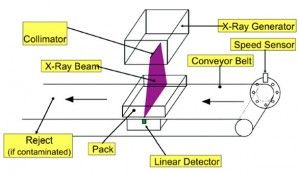X-ray is a type of electromagnetic radiation. Due to their penetrating ability, X-rays are widely used to inspect the inner part of an objects.
Ars inspection systems have been developed as a solution for quality control in mass production and they can be integrated in automatic and semi-automatic production lines.
X-ray quality control systems can perform several tasks (inclusions detection, weighing and differential weighing, integrity and completeness checks, counting), therefore ARS inspection systems can be placed at different steps of the production process, according to the type of analysis to be carried out.
During an inspection process the product is exposed to radiation for a few milliseconds: the radiation power is determined by product density and thickness. Different materials indeed filter the radiation in different ways: the radiation absorption depends on the product density and thickness. In particular, three factors affect absorption:
- Product density and thickness
- Chemical composition (atomic mass number)
- Product consistency or uniformity
The object radiation absorption can be simplified as:
TotalAbsorption = Thickness × SG
where SG is contaminant density.
Consider SG following values for the main contaminants:
As an example in a container with 10 mm of water (SG = 1), the total absorption of radiation is:
TotalAbsorption = (10 mm × SG of 1) = 10
If different contaminants are present inside the same container of water:
- 1 mm Stainless steel (SG 8) => Total absorption (9mm of water with SG 1) + (1mm Stainless steel with SG 8) = 9 + 8 = 17
- 1 mm glass (SG 3.5) Total absorption = (9mm of water with SG 1) + (1mm glass with SG 3.5) = 9 + 3.5 = 12.5
- 3 mm glass (SG 3.5) Total absorption = (7mm of water with SG 1) + (3mm glass with SG 3.5) = 7 + 10.5 = 17.5
We can assume, 1 mm stainless steel has an absorption similar to 3 mm of glass. The previous example shows how the inclusion of 1 mm of stainless steel in a container of 10 mm of water results in 70% change of the total absorption of radiation (product not contaminated= 10; Absorption with 1.0mm SS = 17, Change absorption = + 70%).
If the same product has a thickness of 100 mm, the presence of inclusion (which instead is supposed to remain of the same size as the previous case) will be more difficult to detect: the difference of total absorption will be only 7% (Absorption uncontaminated material = 100, Absorption with 1.0mm SS = 107 Change absorption = + 7%):
Therefore if the thickness of the product increases, the detection sensitivity decreases. After scanning the object, the electromagnetic wave is detected by an electric sensor.
In these detectors, using a semiconductor, the energy of the x-ray is directly converted into an electrical signal that becomes a digital x-rays image. For this reason it is called digital radiology, development of traditional radiography. The latter wouldn’t have allowed process automation because it would have needed a skilled operator able to read and to understand the radiography. X-ray digital image is made by a gray scale: the grey intensity depends on the power with which radiation reaches the sensor once crossed the product.
The second phase of inspection process is the radiological image analysis: through appropriate algorithms the software analizes the x ray digital image. To allow automatic inspection, some variables and their treshold must be identified in order to automatically reject defected parts.
ARS inspection systems use innovative technologies that allow, for example, differential weighing of components inside the same product. ARS QA tools provide better contrast resolution using, where necessary, two radiations with different energy. Combining the information received from two different radiation, you can get more information about the inner structure of an object.
Many markets where inspection systems are aimed, especially food industry, are strictly regulated to protect end users: non-compliant products cause high penalties and sale withdrawal. Compliance may be difficult to verify if non-invasive solutions aren’t introduced.






